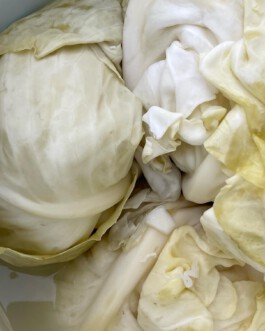
Fermented Cabbage
Fermented cabbage is a staple food during frigid Balkan winters (at least they used to be). In Belgrade, where I partly grew up, every household had Kiseli Kupus (sour cabbage) in their basement, with its pungent smells wafting between the streets.
You need: a big fermentation crock or a food–safe bucket with a lid, fermentation weights to keep the vegetables covered in the brine (the cabbage heads will swim up to the top). And you need a bit of time and patience, for at least 4–6 weeks.


INGREDIENTS
Cabbage heads
Salt, non–iodized, unrefined sea salt, for a 5% brine
water (the amount depends on the weight of your cabbage)
Optional:
Garlic, peeled and slightly squeezed
Pepper corns
Bay leaves
PREPARATION
1. Wash the cabbages. Remove the outer leaves of the cabbage heads, if necessary. Then carefully cut out a piece of the core.
2. Now the brine: weight each cabbage, write down the weight and calculate the amount of salt for a 5% brine. The brine will later fully cover the cabbage heads. But first: put a teaspoon of salt in the cut out parts and let it sit there over night. Then use the following formula:
Weight of salt = weight of cabbage and water x/100-x (the x is the desired brine percentage). For a 5% brine: weight of the cabbage and water x 5 / 95. My grandmother used for each liter of water 1 tablespoon of salt.
Now you have the amount of salt that you need for the brine. Mix well and pour it over your cabbage, make sure to not fill it to the top because the salt in your brine will pull out water from the cabbage and increase the brine, too. Cover with cabbage leaves and a weight. Time to rest. Put the crock in a cool place where it can rest for at least 4–6 weeks until you can enjoy it.
Note:
When making Sauerkraut or other chopped vegetables all you need is salt and the juices that will come out of the vegetables naturally when squeezed. If you want to preserve whole vegetables you need a brine out of salt and water. The concentrations can vary and are a bit higher than for fermenting chopped vegetables, for whole cabbage heads I vary with different concentrations with 3–5 % salt, also depending on the climate, in winter you can use a bit less than in summer.
To avoid surface mold growth, always keep the cabbage submerged in the brine. Therefore put a clean plate, jar or fermentation weight on top of it. When your cabbage is ready, you might find some mold on the surface, just skim it off and remove the upper leaf.
“In both literal and metaphorical fermentation, the fermentation is breaking down previous forms into new forms.”
— Sandor Katz

Fermented Cabbage
Fermented cabbage is a staple food during frigid Balkan winters (at least they used to be). In Belgrade, where I partly grew up, every household had Kiseli Kupus (sour cabbage) in their basement, with its pungent smells wafting between the streets.
You need: a big fermentation crock or a food–safe bucket with a lid, fermentation weights to keep the vegetables covered in the brine (the cabbage heads will swim up to the top). And you need a bit of time and patience, for at least 4–6 weeks.
INGREDIENTS
Cabbage heads
Salt, non–iodized, unrefined sea salt, for a 5% brine
water (the amount depends on the weight of your cabbage)
Optional:
Garlic, peeled and slightly squeezed
Pepper corns
Bay leaves
PREPARATION
1. Wash the cabbages. Remove the outer leaves of the cabbage heads, if necessary. Then carefully cut out a piece of the core.
2. Now the brine: weight each cabbage, write down the weight and calculate the amount of salt for a 5% brine. The brine will later fully cover the cabbage heads. But first: put a teaspoon of salt in the cut out parts and let it sit there over night. Then use the following formula:
Weight of salt = weight of cabbage and water x/100-x (the x is the desired brine percentage). For a 5% brine: weight of the cabbage and water x 5 / 95. My grandmother used for each liter of water 1 tablespoon of salt.
Now you have the amount of salt that you need for the brine. Mix well and pour it over your cabbage, make sure to not fill it to the top because the salt in your brine will pull out water from the cabbage and increase the brine, too. Cover with cabbage leaves and a weight. Time to rest. Put the crock in a cool place where it can rest for at least 4–6 weeks until you can enjoy it.
Note:
When making Sauerkraut or other chopped vegetables all you need is salt and the juices that will come out of the vegetables naturally when squeezed. If you want to preserve whole vegetables you need a brine out of salt and water. The concentrations can vary and are a bit higher than for fermenting chopped vegetables, for whole cabbage heads I vary with different concentrations with 3–5 % salt, also depending on the climate, in winter you can use a bit less than in summer.
To avoid surface mold growth, always keep the cabbage submerged in the brine. Therefore put a clean plate, jar or fermentation weight on top of it. When your cabbage is ready, you might find some mold on the surface, just skim it off and remove the upper leaf.
“In both literal and metaphorical fermentation, the fermentation is breaking down previous forms into new forms.”
— Sandor Katz
a pinch of salt
c/o Tamara Pešić
Ludwigstraße 197
63067 Offenbach
Germany
Pick up & drop times:
Wed, 16:00–19:00
Sat, 13:00–16:00
© Copyright 2022
a pinch of salt
c/o Tamara Pešić
Ludwigstraße 197
63067 Offenbach
Germany
Pick up & drop times:
Wed, 16:00–19:00
Sat, 13:00–16:00
© Copyright 2022